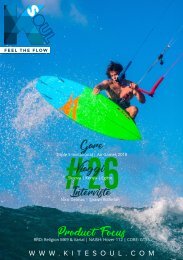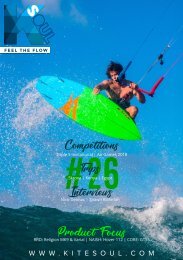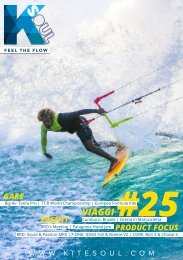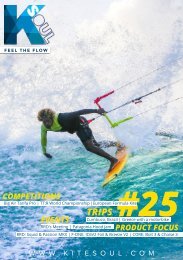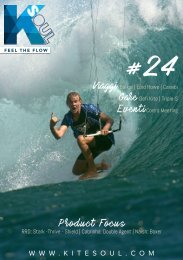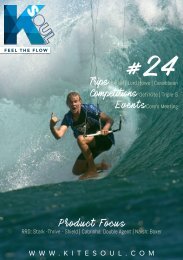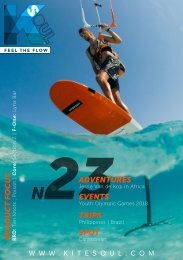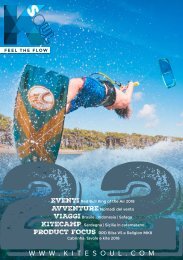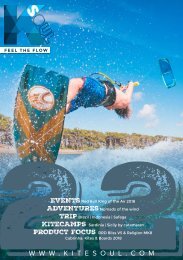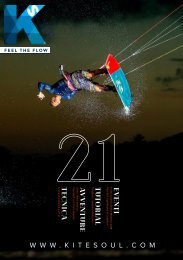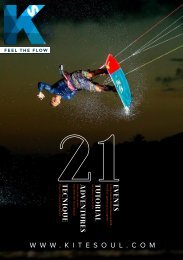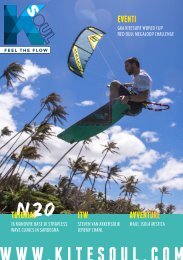Kitesoul Magazine #10 English Edition
Riders columns: Colleen Carroll, Jasse Richman; Events: World Snowkite Contest preview, Blue Palawan Open; ITW: Liam Whaley; Story: Patri MacLaughlin; Trip: Mozambico, Artic Adventure;Tech: Harnesses, Fins; Tutorial: Freestyle moves, Foiloboard, Wave.
Riders columns: Colleen Carroll, Jasse Richman; Events: World Snowkite Contest preview, Blue Palawan Open; ITW: Liam Whaley; Story: Patri MacLaughlin; Trip: Mozambico, Artic Adventure;Tech: Harnesses, Fins; Tutorial: Freestyle moves, Foiloboard, Wave.
Create successful ePaper yourself
Turn your PDF publications into a flip-book with our unique Google optimized e-Paper software.
a lot of support lengthens your<br />
session time....<br />
It goes without saying that the<br />
greater is the support the more<br />
your back will be grateful for it!<br />
MEDIUM (the harness looks very<br />
proportionate)<br />
This typology is a good compromise<br />
for all uses.<br />
LOW (the harness appears very<br />
compact and with a downward<br />
unbalanced shape)<br />
It allows a perfect freedom of<br />
movement against a lesser lumbar<br />
support and hence you will<br />
have an earlier fatigue feeling.<br />
Support distribution<br />
To further complicate the above<br />
distinctions, it must be considered<br />
that, given the same<br />
height support, we must observe<br />
how the "support" has<br />
been deployed. For example,<br />
some harnesses shape may<br />
have a greater support on the<br />
higher area, less support on the<br />
middle area and no support at<br />
all in the lower area so not to<br />
limit front bending. In short, if<br />
you carefully observe the shape<br />
of a harness you will already<br />
be able to understand a lot of<br />
it but, unless you "touch” it and<br />
bend it with your hands, you will<br />
not understand much else.<br />
Hips support<br />
The various models may look<br />
similar from their back design,<br />
but then they differ from one<br />
another for their lateral support.<br />
For example, for wave riding the<br />
profile of the harness may seem<br />
to have the back part similar to<br />
the others but if you look at the<br />
side profile you'll notice less<br />
support in order to not impede<br />
rotations too much.<br />
Flex<br />
The FLEX is related to how rigid<br />
is the material used for making<br />
the support.<br />
A lot of people think that a greater<br />
thickness equals a greater rigidity.<br />
This is not always true as<br />
the degree of resistance of the<br />
material used for the stuffing<br />
does not define rigidity by default<br />
and, as a matter of fact,<br />
this turns out to be often the<br />
opposite ... Greater rigidity, that<br />
is, little flex has without a doubt<br />
three major advantages, especially<br />
for wave riding:<br />
A - Being rigidity undeformable<br />
by definition, the traction<br />
is evenly absorbed by your EN-<br />
TIRE back therefore generally<br />
with less pressure on unwanted<br />
pulling points of your body. In<br />
other words the kg transferred<br />
on each cm of a rigid harness<br />
are less than the ones on a<br />
soft harness where the pulling<br />
points depend on the shape of<br />
the back of the rider and on the<br />
harness design and these pulling<br />
points can be very traumatic<br />
and sometimes cause protrusions<br />
or other dorsal pathologies.<br />
B - A more rigid structure does






